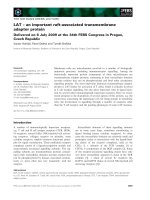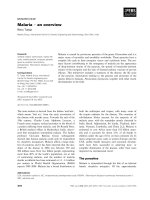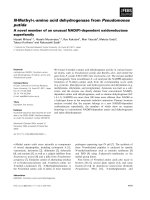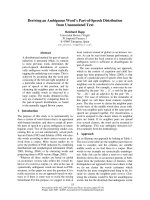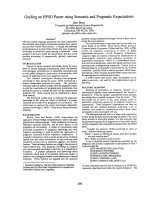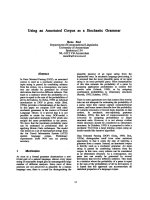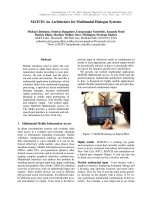báo cáo khoa học: " Establishing an implementation network: lessons learned from community-based participatory research" pps
Bạn đang xem bản rút gọn của tài liệu. Xem và tải ngay bản đầy đủ của tài liệu tại đây (208.06 KB, 7 trang )
BioMed Central
Page 1 of 7
(page number not for citation purposes)
Implementation Science
Open Access
Research article
Establishing an implementation network: lessons learned from
community-based participatory research
Laurie A Lindamer*
1,2
, Barry Lebowitz
1,3
, Richard L Hough
4
, Piedad Garcia
5
,
Alfredo Aguirre
5
, Maureen C Halpain
1,3
, Colin Depp
1,3
and Dilip V Jeste
1,3
Address:
1
Department of Psychiatry, University of California, San Diego, La Jolla, California, USA,
2
Center of Excellence for Stress and Mental
Health (CESAMH), VA San Diego Healthcare Systems, San Diego, California, USA,
3
Stein Institute for Research on Aging, University of California,
La Jolla, California, USA,
4
Psychiatry and Family & Community Medicine, Center for Rural and Community Behavioral Health (CRCBH),
University of New Mexico, School of Medicine, Dexter, New Mexico, USA and
5
San Diego County Adult and Older Adult Mental Health Services,
San Diego, California, USA
Email: Laurie A Lindamer* - ; Barry Lebowitz - ; Richard L Hough - ;
Piedad Garcia - ; Alfredo Aguirre - ; Maureen C Halpain - ;
Colin Depp - ; Dilip V Jeste -
* Corresponding author
Abstract
Background: Implementation of evidence-based mental health assessment and intervention in
community public health practice is a high priority for multiple stakeholders. Academic-community
partnerships can assist in the implementation of efficacious treatments in community settings; yet,
little is known about the processes by which these collaborations are developed. In this paper, we
discuss our application of community-based participatory research (CBPR) approach to
implementation, and we present six lessons we have learned from the establishment of an
academic-community partnership.
Methods: With older adults with psychosis as a focus, we have developed a partnership between
a university research center and a public mental health service system based on CBPR. The long-
term goal of the partnership is to collaboratively establish an evidence-based implementation
network that is sustainable within the public mental healthcare system.
Results: In building a sustainable partnership, we found that the following lessons were
instrumental: changing attitudes; sharing staff; expecting obstacles and formalizing solutions;
monitoring and evaluating; adapting and adjusting; and taking advantage of emerging opportunities.
Some of these lessons were previously known principles that were modified as the result of the
CBPR process, while some lessons derived directly from the interactive process of forming the
partnership.
Conclusion: The process of forming of academic-public partnerships is challenging and time
consuming, yet crucial for the development and implementation of state-of-the-art approaches to
assessment and interventions to improve the functioning and quality of life for persons with serious
mental illnesses. These partnerships provide necessary organizational support to facilitate the
implementation of clinical research findings in community practice benefiting consumers,
researchers, and providers.
Published: 31 March 2009
Implementation Science 2009, 4:17 doi:10.1186/1748-5908-4-17
Received: 29 January 2008
Accepted: 31 March 2009
This article is available from: />© 2009 Lindamer et al; licensee BioMed Central Ltd.
This is an Open Access article distributed under the terms of the Creative Commons Attribution License ( />),
which permits unrestricted use, distribution, and reproduction in any medium, provided the original work is properly cited.
Implementation Science 2009, 4:17 />Page 2 of 7
(page number not for citation purposes)
Background
Effective approaches to implementation of evidence-
based practices in community settings necessarily involve
close collaboration between the research team and the
stakeholders, end-users, and policy-makers responsible
for sustaining the new practices [1-3]. The need for such
collaboration has been recognized by policymakers at the
highest levels of executive decision-making, including, in
the United States, the President's New Freedom Commis-
sion on Mental Health [4].
The nature of the collaboration between community part-
ners and academic researchers varies based upon the rela-
tive distribution of power between the organizations [5-
7]. Three approaches to power sharing have been
described. One approach, "community-targeted"
research, enlists the "voice" of the community to engage
participants in studies that the researcher has selected and
to aid in the dissemination of the research findings [5]. In
a "community-based" research approach, the community
participation is greater. The community has a "vote" in the
selection of research topics, but the researcher often deter-
mines the study design, method of data collection, and
analysis of data. In a "community-driven" research
approach the decision-making for all aspects of the
research is shared, giving the community partner equal
power, and hence the ability to "veto".
Community-driven research methods are akin to commu-
nity-based participatory research (CBPR), an approach
that is solidly established in many areas of public health
research. Its application to developing successful and sus-
tainable mental health implementation networks, how-
ever, is minimal. In order to initiate an implementation
network that bridges the gaps between an academic
research center and a large public mental health system to
create a collaborative implementation research network,
we used the principles of community-based participatory
research (CBPR) [8]. The overall purpose of the network is
to enhance care for older people with schizophrenia and
other psychoses by implementing evidence-based
approaches in community settings. We present six lessons
we have learned from this implementation using our
application of the CBPR approach.
Methods
The setting
The network partners include the Adult and Older Adult
Mental Health Services (AOAMHS) division of San Diego
County and the Division of Geriatric Psychiatry of the Uni-
versity of California, San Diego (UCSD). AOAMHS pro-
vides public supported, linguistically and culturally
appropriate mental health services for a large and diverse
county equal in geographic and population size to the State
of Connecticut (three million). Just over one-half of the cli-
ents (52.5%) are Caucasian, with 19.0% Latino, 11.3%
African American, 4.8% Asian American, 0.6% Native
American, and 11.8% mixed, other or unknown. Histori-
cally, no formalized structure was in place between UCSD
and the county for the support of research, although some
joint clinical projects have been conducted [9,10].
The partnership was developed from funds from the
National Institute of Mental Health designated to support
establishment of research networks. The initial goals of
the partnership included needs assessment, utilization
analysis, public education, and recruitment into research
studies. Details of the outcomes of this partnership have
been described elsewhere [11]. Briefly, however, the part-
nership has accomplished many significant outcomes. For
example, the partners have conducted and disseminated a
system-wide needs analysis of health services for older
adults [12]; investigated the use of mental health services
by gender, ethnicity, age, psychiatric diagnosis, and hous-
ing status [13-18]; provided several educational events,
including a "miniconference" to the 2005 White House
Conference on Aging. Moreover, to increase collaboration
a community advisory board was formed to solicit stake-
holder input at the study design phase of the research
process, and the partners formed a coalition to provide
education and advocacy for older adult mental health
needs that has become a formal program of National Alli-
ance on Mental Illness-San Diego. Here we highlight the
processes by which the collaboration was developed and
maintained, and the lesson we have learned.
Developing the infrastructure for implementation
Public-academic partnerships combine two very different
organizational systems, each with its own goals, values,
styles, limitations, and pressures [19]. For example, the
goal of community mental health systems is to efficiently
provide effective treatments to those with psychiatric dis-
orders with accountability to consumers, families, and
taxpayers. In contrast, academic institutions conduct aca-
demically rigorous investigations of treatments with
accountability to grant agencies, peers, and promotion
committees. Therefore, not only do the types of data differ
between these organizations, but also the method by
which they collect, analyze, and interpret data vary. The
balance between research and action diverges, as do time-
frames and methods for demonstrating success. To
address these organizational differences, we approached
the formation of the partnership as an exercise in "cultural
exchange" that occurs when different groups engage in a
process of debate and compromise [20] to achieve a val-
ued goal [21]. The process is necessarily bi-directional;
both parties contribute, and both derive benefit. We
report, below, on the lessons learned throughout the
processes by which we became familiar with each other's
organization (i.e., goals, values, styles, limitation, and
pressures) that permitted us to accomplish mutually iden-
tified priorities.
Implementation Science 2009, 4:17 />Page 3 of 7
(page number not for citation purposes)
Results and discussion
Lesson one. Changing attitudes
In developing this implementation network, concerns
were raised with respect to liability, confidentiality, and
added responsibilities for already busy clinical and
research staff. As is often reported to be the case with uni-
versity-community ties [22-24], academic researchers
often found the additional bureaucratic processes that are
necessary in public service organizations to be cumber-
some. Then, too, county staff had difficulty with the uni-
versity's organizational and administrative systems.
Moreover, previous interactions had created a set of expec-
tations and barriers that needed to be overcome to achieve
a more effective partnership [8,19]. For example, sustain-
ability of interventions in the community were not
addressed, often leading to a loss of services on which the
county had come to rely. Also, researchers were often not
fully aware of the impact that the implementation of
interventions had on county resources, nor did they
appreciate the numerous levels of accountability for
which the county was responsible (i.e., clients, providers,
tax payers).
Forming a collaborative and productive partnership in the
face of such barriers is complex and time-consuming and
requires mutual trust and respect; changing these pre-
existing attitudes were the initial focus of the relationship
[6,23,25].
Prior to the formation of this partnership, AOAMHS and
the university had no formal research collaborations,
although the organizations had jointly participated in
delivering some clinical services (e.g., psychiatric care for
homeless mentally ill). Previous informal research rela-
tionships, however, had resulted in tension and doubt
about the development of a truly collaborative research
endeavor. It was essential to address these concerns, and
change the attitudes of both partners at the outset.
As part of addressing organizational differences and for-
malizing the structure for the partnership, we held an ini-
tial series of four meetings in the first few months of the
partnership, alternating between sites to educate each
partner about the other's culture. These meetings con-
sisted of presentations by leadership and staff from both
institutions, and discussions on areas of overlap and
mutual benefit. Using the process of consensus, it was
decided that the partnership would focus on the following
areas: needs analysis, education, service utilization review,
and recruitment into specific study protocols.
We originally structured the partnership with three levels,
each with parallel representation from each organization:
staff, administrative, and executive teams. Originally,
partnership staff met weekly or biweekly to discuss opera-
tions and projects. Higher level leadership from the
county and the university joined staff monthly to address
broader policy issues, resource allocation, and other
administrative tasks. The county directors and the director
of the research center joined the group quarterly for exec-
utive meetings to review progress and determine opera-
tional and research priorities. Over time, however, we
found that the administrative and executive meetings
were adequate for oversight and coordination, and dis-
continued the more frequent staff meetings replacing
them with regular meetings to discuss scientific progress.
These meetings were held monthly and included investi-
gators, county staff, and the jointly hired personnel. Con-
sistent with the cultural exchange model, not only did
each organization change as the result of the transaction
between the partners, but also the jointly established
structures (i.e., staff meetings) were modified as the needs
of the collaboration evolved.
Lesson two. Sharing staff
Another lesson that required immediate attention was
determining the allocation of resources specifically dedi-
cated to the formation of the partnership. Both AOAMHS
and the university recognized that personnel committed
to the partnership development were an important invest-
ment. To increase communication, to assist in the under-
standing of each other's culture, and to foster
cohesiveness, we jointly hired staff specifically for the
partnership. The NIMH-funded center grant provided
funds for a community mental health liaison and a data
analyst to provide support to the county, who were
housed at county offices for the express purpose of
increasing communication. We also hired a research
assistant whose time was shared between the UCSD and
the county to aid in the development of reports and edu-
cational materials. Also, when the state budget crisis
threatened the funding for the AMHS-funded position of
the 'Older Adult Mental Health Coordinator', the partner-
ship assumed financial responsibility for that position.
The jointly hired personnel, as well as staff from each
organization, collaborated to ensure equal representation
in all aspects of research, which is consistent with the prin-
ciples CBPR. Education programs targeting the various
stakeholder groups were developed and implemented.
For example, an initiative identified by the county prior to
the partnership was to provide a major educational pro-
gram, 'The Wellness Campaign', for the general public. We
collaboratively developed of a series of lectures given by
national experts on such topics as the prevalence of psy-
chiatric disorders, mental health assessment, depression
and suicide, and psychopharmacological treatment in
older adults. A broad audience of as many as 100 attend-
ees, including researchers, providers, advocates, caregiv-
ers, and consumers, heard presentations at various
Implementation Science 2009, 4:17 />Page 4 of 7
(page number not for citation purposes)
accessible venues throughout the county, including senior
centers and other community meeting sites. The program
included a formal presentation and discussion, distribu-
tion of informational materials, and opportunities for
networking.
In addition to increasing awareness of mental health
issues of older persons to the general community, joint
staff members made presentations to staff of various local
and state agencies responsible for health and social serv-
ices. Topics have included introducing evidence-based
practices at a statewide meeting of county mental health
directors and describing the nature and benefits of public-
academic partnerships to researchers, and offering a
'refresher' course on research concepts for agency provid-
ers. In addition, senior university psychiatrists have been
speakers for county-sponsored continuing medical educa-
tion programs for physicians. Finally, the center, as well as
AOAMHS, was co-sponsors of a consumer forum on late-
life mental illness held in the spring of 2005 that was
organized by the Geriatric Mental Health Foundation to
gather input as part of a White House Conference on
Aging.
Center staff members have also been instrumental in
developing a new community-based, cooperative coali-
tion, the Senior Wellness Coalition – San Diego. The coa-
lition has been awarded a $34,000 California Endowment
Foundation Grant to support its work in capacity-building
and coordination. The center partnership also maintains
representation on an Older Adult System of Care Council
that provides recommendations to the local mental health
director.
These educational activities, which indirectly pertain to
research, required a substantial amount of the partnership
resources and time. Inherent tensions associated with dif-
ferent emphases on tasks and processes are a common
obstacle faced by partnerships [26], and the time needed
to complete some tasks can be a major barrier to achieving
partnership objectives [25]. Yet, these outreach efforts
have resulted in numerous tangible benefits. The center
and the county continued to gain knowledge about the
other's culture through the implementation of these pro-
grams. Trust and respect were enhanced through an equi-
table distribution of decision-making and
responsibilities.
Lesson three. Expecting obstacles and formalizing
solutions
As successful, independent operations, both the county
and the center have developed strategies for solving prob-
lems and overcoming barriers. In the development of the
partnership, however, fiscal and administrative problems
emerged that neither organization anticipated. For exam-
ple, we initially planned to have the county administer the
budget for the partnership through a subcontract with the
university. Because some university groups held contracts
with the county to provide clinical services, AOAMHS
could enter into a contract in which it received funds from
the univerisity, even those funds provided by NIMH and
designated specifically for the purposes of the collabora-
tion. In order to progress with the development of the
partnership, these unanticipated administrative and pro-
cedural issues had to be resolved. Through negotiation
and compromise, requiring that each institution look
beyond its distinct set of organizational priorities and loy-
alties [27,28], the partners decided that the university
would manage the entire budget. The university became
the designated employer of all staff, and the staff located
at the county sites obtained 'volunteer' status. Both part-
ners, however, retained joint determination of budget
allocations, personnel selection, and supervision. This
agreement and others were documented in a formal mem-
orandum of understanding that outlined the terms of the
collaboration and provided for annual review and revi-
sion, if necessary. The memorandum was developed with
NIMH input and submitted as a formal amendment to the
center grant award.
Another obstacle encountered by the partnership was
recruitment of county participants into ongoing and new
study protocols to increase the representation of our
research samples. The shared staff facilitated identifica-
tion of new recruitment sources and reduced the time
spent on duplicative administrative aspects of obtaining
approval to recruit at different county-affiliated sites. A
major initiative involved collaboration with the County
Public Conservator's Office, which is responsible for per-
sons judged to be in need of the extra protection of guard-
ianship, to develop policies that would allow
participation of such individuals in minimal risk research
projects. In the past, persons under public conservator-
ship were not permitted to participate in any type of
research. University staff involved in the partnership, as
well as the jointly hired staff, approached the director of
the conservatorship program to explain the nature of the
research projects, human subjects issues (i.e., the
informed consent process, and minimum risk protocols),
and the partnership itself. The director was invited to par-
ticipate in executive staff meetings during which top
county officials expressed their endorsement of partner-
ship, and the collaborative and thorough nature of the
process was demonstrated. The director agreed to modify
the policy and allow the enrollment of conservatorized
persons (with individual assent and conservator consent)
in minimal-risk research as defined in 45CFR46 [29],
helping to make the study samples more representative
and increasing the potential applicability of findings to
clinically fragile or disabled individuals. At that time,
Implementation Science 2009, 4:17 />Page 5 of 7
(page number not for citation purposes)
there were nine research protocols in which about 30 pub-
licly conservatorized persons were participating.
The formation of a CBPR partnership by definition
involves agencies with differing styles and procedures. The
success of the collaboration depends heavily on the ability
of the partners to anticipate and address obstacles in ways
that each may have never previously considered.
Lesson four. Monitoring and evaluating
UCSD and the county each had institutional mechanisms
to track research projects. The formal mechanisms
included the University's Human Research Protections
programs and the County Research Committee. Because
the county had limited capacity to review and monitor
projects, the number of projects active in county programs
was restricted. The partners worked to harmonize these
processes in order to reduce the burden on the organiza-
tions and investigators, and created a database to track
projects from initial proposal through study completion.
Other databases were created to track subject participation
and publications and reports. In general, the organiza-
tional expertise of the county complemented the scientific
expertise of the academic investigators to create a moni-
toring and evaluation structure that assists investigators in
the preparation of necessary documents, that reduces the
demand on county resources, and that mitigates excessive
subject burden by tracking the research participation of
county clients.
The ability to monitor and evaluate outcomes and
progress proved to be a crucial task of the partnership. The
values of each organization differ, as do the methods
employed to ensure the adherence to them; therefore,
establishing mechanisms to monitor jointly agreed upon
goals greatly facilitates communication and cohesion
between the partners.
Lesson five. Adapting and adjusting
Public-academic partnerships are established within a
fluid context of political processes, changing priorities,
and other events all of which require a flexible and adap-
tive approach not typically required in academic research.
The partnership encountered three such challenges:
changes of the county leadership, a natural disaster, and
significant budget cutbacks. Each of these resulted in a
resetting of project timetables that allowed staff to accom-
modate to the requirements of the moment. That the part-
nership survived and flourished indicates the strength of
the arrangement and the validity of the pursuit. A good
example is the implementation of the Privacy Rule of the
Health Insurance Portability and Accountability Act
(HIPAA) [30] regulating the use of medical data. This
necessitated development of a new data use agreement to
ensure that the data transfer between the partners was
HIPAA-compliant. This agreement enabled investigators
to retain access to de-identified information from the
county's database, and a number of reports and publica-
tions have resulted.
Consistent with CBPR, the needs of both partners were
equal. This necessitated at times that one partner had to
re-evaluate and modify priorities in response to the other
partner's issues. Moreover, both partners contributed
equally to determining solutions to changes. These proc-
esses took much time and effort and may have slowed
progress, but the result was a solution that satisfied both
the county and the center.
Lesson six. Taking advantage of emerging opportunities
In November 2004, Californians passed Proposition 63,
the Mental Health Services Act (MHSA). The MHSA gener-
ates new tax revenue specifically earmarked to expand
mental health services for the seriously mentally ill. The
guiding purpose of this program was to transform the
delivery of mental health services in California by institut-
ing a recovery-oriented vision for new and expanded serv-
ices and placing these services into the real world of
homes, peer-run centers, clinics, and schools. For San
Diego County, this has resulted in a budget increase of
nearly $29 million through fiscal year 2007/2008. One of
the key features of the MHSA was that each county was
required to prioritize its own mental health needs, and in
collaboration with a range of stakeholders, including con-
sumers and family members, providers, and advocates,
determine how the money would be used, emphasizing
the need to deliver comprehensive services to a limited
number of people rather than just broadly increasing serv-
ices across the whole system. The UCSD-county partner-
ship was instrumental in gathering, consolidating and
analyzing stakeholder input and in conducting service uti-
lization analyses that formed the core of the San Diego
plan. which was approved with highest enthusiasm by the
state's review committees.
The passage of the MHSA was not anticipated when the
initial objectives of the partnership were selected. None-
theless, the synergy of the partnership created several
opportunities to further its goals and those of the MHSA.
For example, we jointly conducted a needs assessment
that not only fulfilled one of the goals of the partnership,
but also provided important information for the planning
of MHSA funds.
Outcomes and benefits
Along with special analyses that were prepared as part of
the county's MHSA application, investigators in the part-
nership have collaborated to complete nine studies; eight
of these have been published on topics such as gender dif-
ferences [13], ethnic disparities [14], and diagnostic- and
Implementation Science 2009, 4:17 />Page 6 of 7
(page number not for citation purposes)
age-related factors [15,16]. affecting service utilization for
patients with schizophrenia, risk factors for homelessness
[17], and the differential occurrence of substance and
alcohol use disorders among different ethnic groups [31].
We conducted two studies linking the county's database
with state Medicaid data. In one study, we found that res-
idents of assisted care facilities had greater use of outpa-
tient mental health services and lower rates of psychiatric
and non-psychiatric hospitalization [18]. In the other
study, we found that 41% of patients with schizophrenia
were fully adherent and 16% were partially adherent to
their prescribed antipsychotic drug schedule, and that
both psychiatric and medical hospitalizations were
strongly related to the degree of drug adherence [32]. The
center provided a unique environment for the combina-
tion of academic and programmatic expertise necessary to
pursue these analyses, which yielded valuable informa-
tion for mental health services researchers and adminis-
trators.
Conclusion
In establishing a network for implementation between an
academic center and public mental health system based
on CBPR, we encountered several issues that may general-
ize beyond our goal of the development and implementa-
tion of state-of-the-art approaches to assessment and
interventions to improve the functioning and quality of
life for persons with serious mental illnesses. The set of six
"lessons learned" – changing attitudes; sharing staff;
expecting obstacles and formalizing solutions; monitor-
ing and evaluating; adapting and adjusting; and taking
advantage of emerging opportunities – most likely will be
applicable to the formation of other partnerships
designed to provide necessary organizational support to
facilitate the moving of the results of clinical research into
community practice.
Starting with successful models of other academic-public
collaborations [5,8]. and modifying them to the specific
needs of the partners and the population, UCSD and San
Diego County created a partnership focused on older
adults with psychosis. The organizing rationale for this
center was to establish an evidence-based partnership
approach that adopted the principles of community-
based participatory research in order to facilitate imple-
mentation of evidence-based approaches to assessment
and intervention. The cultural exchange between two
organizations that differed vastly in values orientations,
bureaucracy, and function required a substantial invest-
ment of time, a strong commitment to the process, an
openness to change, flexibility in the face of shifting con-
texts and priorities, and willingness to compromise and
accommodate. The partnership received the endorsement
of the top leadership in both organizations, an important
factor in promoting cohesiveness and cooperation.
Through this process, San Diego County has developed an
infrastructure to support research, educational and advo-
cacy programs (i.e., Senior Mental Health Coalition), and
the furthered the development of the mental health deliv-
ery system for older adults. For example, MHSA funds
support a mobile outreach team for older adults, a need
that was identified through the needs assessment. The
university has gained knowledge and awareness of com-
munity mental health services conditions, and improved
its ability to develop and implement effective community-
based participatory research projects for older persons
with serious mental illnesses.
Competing interests
The authors declare that they have no competing interests.
Authors' contributions
LAL, BL, and RLH were responsible for the initial concep-
tualization and writing of the manuscript. PG, AA, MCH,
CD, DVJ have been involved in revising the manuscript
and adding substantial intellectual content. All authors
read and approved the final manuscript.
Acknowledgements
This work was supported, in part, by the National Institute of Mental Health
grant MH66248, the Department of Veterans Affairs. We gratefully
acknowledge the effort, commitment, and passion of the Research Net-
work Development Core members: Viviana Criado, M.S., Rebecca Daly,
Jody DelaPena, BS, MBA, Dahlia Fuentes, MSW, MPH; and Julie Nadeau-
Manning, MSW.
References
1. Kilbourne AM, Neuman MS, Pincus HA, Bauer MS, Stall R: Imple-
menting evidence-based interventions in health care: appli-
cations of the replicating effective programs framework.
Implementation Science 2007, 2:42.
2. Madon T, Hofman KJ, Kupfer L, Glass RI: Implementation science.
Science 2007, 318:1728-1729.
3. Fixsen DL, Naoom SF, Blase KA, Friedman RM, Wallace F: Implemen-
tation Research: A Synthesis of the Literature Tampa, FL: University of
South Florida, Louis de la Parte Florida Mental Health Institute, The
National Implementation Research Network; 2005.
4. New Freedom Commission on Mental Health: Achieving the Promise:
Transforming Mental Health Care in America. Final Report Rockville, MD:
Department of Health and Human Services; 2004.
5. Wells K, Miranda J, Bruce ML, Alegria M, Wallerstein N: Bridging
community intervention and mental health services
research. Am J Psychiatry 2004, 161:955-963.
6. Baker EA, Homan S, Schonhoff R, Kreuter M: Principles of practice
for academic/practice/community research partnerships.
Am J Prev Med 1999, 16:86-93.
7. Green LW, Mercer SL: Can public health researchers and agen-
cies reconcile the push from funding bodies and the pull from
communities. Am J Public Health 2001, 91:1926-1929.
8. Israel BA, Schulz AJ, Parker EA, Becker AB: Review of community-
based research: Assessing partnership approaches to
improve public health. Annu Rev Public Health 1998, 19:173-202.
9. Barrio C, Yamada AM, Yamada SY, Hough RL: San Diego County Mental
Health Services Cultural Competence System-Wide Assessment. Technical
Report San Diego: San Diego County Adult Mental Health Services;
2002.
10. Hawthorne WB, Lohr JB, Green EE, Garcia P, Gilmer TP, Hough RL,
Hammond L, Lee M: A client-centered alternative to acute psy-
chiatric hospitalization: Short-term outcomes for veterans
in a randomized trial. Psych Serv 2005, 56:1379-1386.
Publish with BioMed Central and every
scientist can read your work free of charge
"BioMed Central will be the most significant development for
disseminating the results of biomedical research in our lifetime."
Sir Paul Nurse, Cancer Research UK
Your research papers will be:
available free of charge to the entire biomedical community
peer reviewed and published immediately upon acceptance
cited in PubMed and archived on PubMed Central
yours — you keep the copyright
Submit your manuscript here:
/>BioMedcentral
Implementation Science 2009, 4:17 />Page 7 of 7
(page number not for citation purposes)
11. Lindamer LA, Lebowitz BD, Hough RL, Garcia P, Aquirre A, Halpain
MC, Depp C, Jeste DV: Improving care for older persons with
schizophrenia through an academic-community partner-
ship. Psychiatr Serv 2008, 59:236-239.
12. Palinkas LA, Criado V, Fuentes D, Shepherd S, Milian H, Folsom D,
Jeste DV: Unmet needs for services for older adults with men-
tal illness: comparison of views of different stakeholder
groups. Am J Geriatr Psychiatry 2007, 15:530-540.
13. Lindamer LA, Bailey A, Hawthorne W, Folsom DP, Gilmer TP, Garcia
P, Hough RL, Jeste DV: Gender differences in characteristics
and service use of public mental health patients with schizo-
phrenia. Psychiatr Serv 2003, 54:1407-1409.
14. Barrio C, Yamada A-M, Hough R, Hawthorne W, Garcia P, Jeste DV:
Ethnic disparities in utilization of public mental health care
management services among clients with schizophrenia. Psy-
chiatr Serv 2003, 54:1264-1270.
15. Jin H, Folsom DP, Lindamer L, Bailey A, Hawthorne W, Garcia P, Jeste
DV: Patterns of service use by age in patients with schizo-
phrenia in a large public mental health system. Am J Geriatr
Psychiatry 2003, 11:525-533.
16. Depp C, Lindamer LA, Folsom DP, Gilmer T, Hough RL, Garcia P,
Jeste DV: Differences in clinical features and mental health
service use in bipolar disorder across the lifespan. Am J Geriatr
Psychiatry 2005, 13:290-298.
17. Folsom DP, Hawthorne W, Lindamer L, Gilmer T, Bailey A, Golshan
S, Garcia P, Unutzer J, Hough R, Jeste DV: Prevalence and risk fac-
tors for homelessness and utilization of mental health serv-
ices among 10,340 patients with serious mental illness in a
large public mental health system. Am J Psychiatry 2005,
162:370-376.
18. Gilmer TP, Folsom DP, Hawthorne W, Lindamer LA, Hough RL, Gar-
cia P, Jeste DV: Assisted living and use of mental health serv-
ices among Medicaid beneficiaries with schizophrenia. J Ment
Health Policy Econ 2003, 6:59-65.
19. Santos AB, Ballenger JC, Bevilacqua JJ, Zealberg JJ, Hiers TG, McLeod-
Bryant S, Deci PA, Rames LJ: A community-based public-aca-
demic liaison program. Am J Psychiatry 1994, 151:1181-1187.
20. Bailey FG: Debate and Compromise: The Politics of Innovation
Totowa,
NJ: Rowman & Littlefield; 1973.
21. Palinkas LA, Allred CA, Landverk J: Models of research-opera-
tional collaboration for behavioral health in space. Aviation,
Space and Environmental Medicine 2005, 76:B52-B60.
22. Gills D: Unequal and uneven: Critical aspects of community-
university partnerships. In Collaborative research: University and
community partnership Edited by: Sullivan M, Kelly JG. Washington,
DC: American Public Health Association; 2001.
23. Wolff M, Maurana CA: Building effective community-academic
partnerships to improve health: A qualitative study of per-
spectives from communities. Acad Med 2001, 76:166-172.
24. Cortes M: Public-policy partnerships between universities and
communities. National Civic Review 1998, 87:163-169.
25. Roussos ST, Fawcett SB: A review of collaborative partnerships
as a strategy for improving community health. Annu Rev Public
Health 2000, 21:369-402.
26. Israel BA: Commentary: Model of community health govern-
ance: Applicability to community-based participatory
research partnerships. Journal of Urban Health: Bulletin of the New
York Academy of Medicine 2003, 80:50-53.
27. Phelan EA, Cheadle A, Schwartz SJ, Snyder S, Williams B, Wagner EH,
LoGerfo JP: Promoting health and preventing disability in
older adults: Lessons from intervention studies carried out
through an academic-community partnership. Family & Com-
munity Health 2003, 26:214-220.
28. Mitchell SM, Shortell SM: The governance and management of
effective community health partnerships: A typology for
research, policy, and practice. Milbank Q 2000, 78:241-289.
29. United States Department of Health and Human Services
[ />45cfr46.htm#46.116]
30. Standards for Privacy of Individually Identifiable Health
Information. 45 CFR Parts 160 and 164 [http://
www.cms.hhs.gov/HIPAAGenInfo/]
31. Montross L, Barrio C, Yamada A-M, Lindamer L, Garcia P, Fuentes D,
Hough RL, Jeste DV: Tri-ethnic variations of co-morbid sub-
stance and alcohol use disorders in schizophrenia. Schizophr
Res 2005, 79:297-305.
32. Gilmer TP, Dolder CR, Lacro JP, Folsom D, Lindamer L, Garcia P,
Jeste DV: Adherence to treatment with antipsychotic medica-
tion and healthcare costs among medicaid beneficiaries with
schizophrenia. Am J Psychiatry 2004, 161:692-699.
